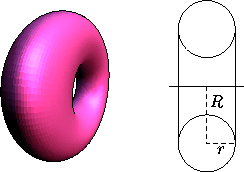 the distance from this centroid
to the axis of revolution).
the distance from this centroid
to the axis of revolution).
Next: 16 Quadrics
Up: Part II: Three-Dimensional Geometry
Previous: 14 Spheres
A surface of revolution is formed by the rotation of a planar curve C about an axis in the plane of the curve and not cutting the curve. The Pappus--Guldinus theorem says that:
 the distance from this centroid
to the axis of revolution).
the distance from this centroid
to the axis of revolution).
When C is a circle, the surface obtained is a circular torus or
torus of revolution (Figure 1). Let r be the
radius of the revolving circle and let R be the distance from its
center to the axis of rotation. The area of the torus is
4
 Rr, and its volume is 2
Rr, and its volume is 2
 Rr
Rr .
.

Figure 1: A torus of revolution.
![[HOME]](/pix/home.gif) The Geometry Center Home Page
The Geometry Center Home PageSilvio Levy
Wed Oct 4 16:41:25 PDT 1995
This document is excerpted from the 30th Edition of the CRC Standard Mathematical Tables and Formulas (CRC Press). Unauthorized duplication is forbidden.